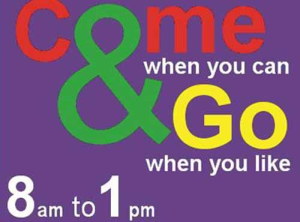This story illustrates the principles of The UP dimension of church in the Guide.
 Coming and going throughout a church service is not common practice in the western tradition. But in January 2006, a church in north London created a Sunday morning schedule which allows people to stay for as long or as short a time as they like.
Coming and going throughout a church service is not common practice in the western tradition. But in January 2006, a church in north London created a Sunday morning schedule which allows people to stay for as long or as short a time as they like.
Services start at eight o’clock in the morning and conclude at one o’clock, in half-hour blocks, an alternative to the previous practice of three traditional services. Members of the congregation may enter or leave at any time, but the half-hour segments make for planned opportunities to change.
While some people stay for five minutes, others stay for the whole five hours, experiencing the differing approaches to worship throughout the morning.
Sunday begins with a more formal style of worship and moves to a more contemporary style, with time in between for conversation and prayer.
The Come & Go programme is designed so that you will get a fairly well-balanced spiritual diet if you stay for about one and a half hours,
explains vicar, Rob Harrison. Every half hour has a different style and approach. Each Sunday, a single theme runs through the morning’s worship, but each section explores that theme in a different way.
Eating together is central to each section, following the practice of the early church where eating together was commonplace.
This new pattern of worship is effective on two levels.
On one level it gives the previously separate congregations more of a sense of belonging to one another,
says Rob.
The overlapping of worshippers among the different sections adds to this sense of continuity.
On a second level, the pattern provides more opportunities for individuals to feel part of a community within St John’s. This particularly happens over breakfast and lunch, and in the planned discussion sections in both the mid and late morning phases.
 Communion happens three times: in the first hour with a Book of Common Prayer service, in the middle of the morning with a Common Worship service, and as ‘an informal meal rather than a formal liturgical act’ at noon. Children’s groups happen in the middle of the morning in the church hall, returning for the mid-morning Family Communion. The late morning sections are planned as ‘All Age’ worship.
Communion happens three times: in the first hour with a Book of Common Prayer service, in the middle of the morning with a Common Worship service, and as ‘an informal meal rather than a formal liturgical act’ at noon. Children’s groups happen in the middle of the morning in the church hall, returning for the mid-morning Family Communion. The late morning sections are planned as ‘All Age’ worship.
We want to make it possible for as many people as possible who want to worship God, to do so,
says Rob, whose registered congregation has grown by 15 per cent since Come & Go was introduced.
We deliberately shaped the new pattern so that if people came at much the same time as before, they would get much the same experience.
Come & Go features in Encounters on the Edge, issue 35.

